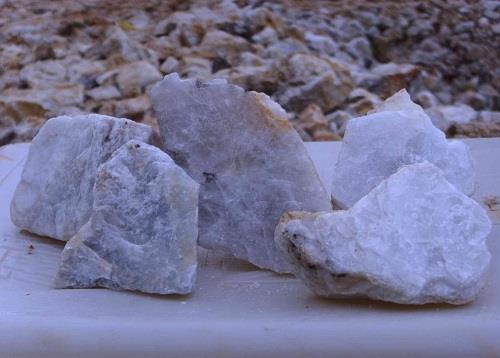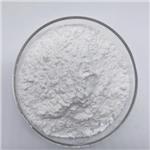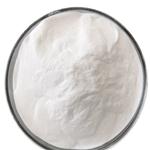Chemical Properties
| Density | 4.300 g/cm3 |
| EPA Substance Registry System | Barite (13462-86-7) |
Usage And Synthesis
Barite, a name that was derived from the Greek word "barus" (heavy), is the mineralogical name for barium sulfate. In commerce, the mineral is sometimes referred to as "barytes." It serves as the principal Ore of Barium, which is used to make a wide variety of barium compounds.
Barite is well-known for its great range of colors and varied crystal habits. It is easily identifiable by its heavy weight, since most similar minerals are much lighter.
Mineral Properties
Chemical formula: Barium Sulfate BaSO4
Color(s): Transparent, White, Gray, Yellow, Blue, Red, Brown
Luster: Vitreous, Greasy
Crystal system: Orthorhombic
Transparency: Transparent To Translucent
Specific Gravity: 4.4
Hardness (Mohs): 3–3.5
Location: Barite is widespread in existence.

Because of Barites chemical properties and high specific gravity, it is one of the most amazing minerals used for a range of industrial, medical and manufacturing applications. This mineral has many uses from cooling the bits in oil drilling operations, manufacturing of paints and because it is opaque to x-rays, also used for medical applications.
Barite is well-known for its great range of colors and varied crystal habits. It is easily identifiable by its heavy weight, since most similar minerals are much lighter.
Mineral Properties
Chemical formula: Barium Sulfate BaSO4
Color(s): Transparent, White, Gray, Yellow, Blue, Red, Brown
Luster: Vitreous, Greasy
Crystal system: Orthorhombic
Transparency: Transparent To Translucent
Specific Gravity: 4.4
Hardness (Mohs): 3–3.5
Location: Barite is widespread in existence.

Because of Barites chemical properties and high specific gravity, it is one of the most amazing minerals used for a range of industrial, medical and manufacturing applications. This mineral has many uses from cooling the bits in oil drilling operations, manufacturing of paints and because it is opaque to x-rays, also used for medical applications.
Barite is widely distributed in nature and occurs as the mineral barite (also known as barytes or heavy spar). It often is associated with other metallic ores, such as fluorspar. Barites containing over 94% BaSO4 can be processed economically.
Barite has many commercial applications. It is used as natural barite, or precipitated BaSO4. The precipitated salt in combination with equimolar amount of co-precipitated zinc sulfide formerly was used as a white protective coating pigment, known as lithophone. Similarly, in combination with sodium sulfide, it is used to produce fine pigment particles of uniform size, known as blanc fixe. Natural barite, however, has greater commercial application than the precipitated salt. It is used as drilling mud in oil drilling to lubricate and cool the drilling bit, and to plaster the walls of the drill hole to prevent caving. It is used as a filler in automotive paints, plastics and rubber products. It also is used in polyurethane foam floor mats; white sidewall rubber tires; and as a flux and additive to glass to increase the refractive index.
Other chemical applications of barium sulfate are as the opaque ingredient in a barium meal for x-ray diagnosis; as a pigment for photographic paper; and to prepare many barium salts.
Barite has many commercial applications. It is used as natural barite, or precipitated BaSO4. The precipitated salt in combination with equimolar amount of co-precipitated zinc sulfide formerly was used as a white protective coating pigment, known as lithophone. Similarly, in combination with sodium sulfide, it is used to produce fine pigment particles of uniform size, known as blanc fixe. Natural barite, however, has greater commercial application than the precipitated salt. It is used as drilling mud in oil drilling to lubricate and cool the drilling bit, and to plaster the walls of the drill hole to prevent caving. It is used as a filler in automotive paints, plastics and rubber products. It also is used in polyurethane foam floor mats; white sidewall rubber tires; and as a flux and additive to glass to increase the refractive index.
Other chemical applications of barium sulfate are as the opaque ingredient in a barium meal for x-ray diagnosis; as a pigment for photographic paper; and to prepare many barium salts.
Barium sulfide is prepared by heating barite with coal or petroleum coke in a rotary kiln at 1,000°C to 1,250°C in an oxygen-free atmosphere:
BaSO4+ 4C——>BaS + 4CO
The product, black ash, is a gray or black powder containing carbonaceous impurities and unreacted barite. Barium sulfide is separated from impurities by extraction with hot water and filtration. It is obtained as an aqueous solution of 15 to 30% strength. The commercial product is 80% to 90% BaS.
Barium sulfide may also be made by high temperature reduction of barium sulfate with methane.
BaSO4+ 4C——>BaS + 4CO
The product, black ash, is a gray or black powder containing carbonaceous impurities and unreacted barite. Barium sulfide is separated from impurities by extraction with hot water and filtration. It is obtained as an aqueous solution of 15 to 30% strength. The commercial product is 80% to 90% BaS.
Barium sulfide may also be made by high temperature reduction of barium sulfate with methane.
Barite is the primary, naturally occurring, barium-based mineral.Barium, atomic number 56, derives its name from Greek and means heavy. Barite is also known as baryte, and in Missouri is known as "tiff”. The primary countries in which commercial deposits of barite are currently found are the United States, China, India and Morocco. Barite’s high density and chemical inertness make it an ideal mineral for many applications.
The chemical formula for barite is BaSO4. It has a high specific gravity of 4.50 g/cm3. Its Mohs hardness is 3.0 to 3.5. Barite, which may be found in a variety of colors including yellow, brown, white, blue, gray, or even colorless, typically has a vitreous to pearly luster.
Barite may be found in conjunction with both metallic and nonmetallic mineral deposits. To be economically viable for extraction, barite usually needs to be the predominant material in a deposit. The types of deposits in which it is normally found include vein, residual, and bedded. Vein and residual deposits are of hydrothermal origin, while bedded deposits are sedimentary.
The chemical formula for barite is BaSO4. It has a high specific gravity of 4.50 g/cm3. Its Mohs hardness is 3.0 to 3.5. Barite, which may be found in a variety of colors including yellow, brown, white, blue, gray, or even colorless, typically has a vitreous to pearly luster.
Barite may be found in conjunction with both metallic and nonmetallic mineral deposits. To be economically viable for extraction, barite usually needs to be the predominant material in a deposit. The types of deposits in which it is normally found include vein, residual, and bedded. Vein and residual deposits are of hydrothermal origin, while bedded deposits are sedimentary.
Barite is a frequent fluorescent,most commonly displaying a not very saturated or intense light yellow color. Barite is found as beautiful and showy crystals in several places in South Dakota, particularly in the area of the Cheyenne and Moreau rivers.The barite crystals are tan to brown, glassy and transparent. Under short wave ultraviolet, these barites fluoresce butter yellow.Often there is a phosphorescence, usually a strong green-white.Accompanying calcite also fluoresces yellow, but more orange than the barite, and the combination of barite and calcite makes an attractive fluorescent combination.
Barite is found as white to tan flat crystals standing on fluorite from the Buckskin Mountains, Yuma County, Arizona. This barite fluoresces orange-tan under long wave ultraviolet,while the fluorite responds with its usual blue,forming another attractive two-color fluorescent combination.Barite is also found at Bingham, New Mexico, as thick,white, blady crystals with fluorite. In these specimens, the barite fluoresces deep pink or weak red while the fluorite fluoresces blue,under long wave. Weak red fluorescing barite with fluorescing fluorite is also found at Elmwood, Tennessee.
Barite is found as white to tan flat crystals standing on fluorite from the Buckskin Mountains, Yuma County, Arizona. This barite fluoresces orange-tan under long wave ultraviolet,while the fluorite responds with its usual blue,forming another attractive two-color fluorescent combination.Barite is also found at Bingham, New Mexico, as thick,white, blady crystals with fluorite. In these specimens, the barite fluoresces deep pink or weak red while the fluorite fluoresces blue,under long wave. Weak red fluorescing barite with fluorescing fluorite is also found at Elmwood, Tennessee.
Barite also is used as a filler, extender, or weighting agent in products such as paints, plastics, and rubber. Some specific applications include use in automobile brake and clutch pads, automobile paint primer for metal protection and gloss, use as a weighting agent in rubber, and in the cement jacket around underwater petroleum pipelines. In the metal-casting industry, barite is part of the mold-release compounds. Because barite significantly blocks x-ray and gamma-ray emissions, it is used as aggregate in high-density concrete for radiation shielding around x-ray units in hospitals, nuclear powerplants, and university nuclear research facilities. Ultrapure barite is used as a contrast medium in x-ray and computed tomography examinations of the gastrointestinal tract.
barium sulphate: An insolublewhite solid, BaSO4, that occurs naturallyas the mineral barytes (orheavy spar) and can be prepared as aprecipitate by adding sulphuric acidto barium chloride solution; r.d. 4.50;m.p. 1580°C. The rhombic formchanges to a monoclinic form at1149°C. It is used as a raw materialfor making other barium salts, as apigment extender in surface coatingmaterials (called blanc fixe), andin the glass and rubber industries.Barium compounds are opaque toX-rays, and a suspension of the sulphatein water is used in medicine toprovide a contrast medium for X-raysof the stomach and intestine. Althoughbarium compounds are extremelypoisonous, the sulphate issafe to use because it is very insoluble.
Barite manufacturers
Related articles
Uses and Occurrence of BariteJul 14,2022
PROMPT×
PROMPT
The What'sApp is temporarily not supported in mainland China
The What'sApp is temporarily not supported in mainland China
Cancel
Determine



